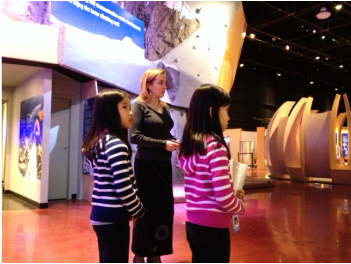 Amelie and Michelle with Dr. Jane Conboy
Amelie and Michelle with Dr. Jane Conboy Andrea Mus, the Media Relations Officer, welcomed us and brought us to Dr. Conboy. We interviewed them first before they took us on a tour on the AstraZeneca Human Edge exhibition.
“There were a couple of things that helped The AstraZeneca Human Edge exhibition start,” Dr. Conboy said. “There was a sports exhibit that people loved, and a human body exhibit upstairs. They were both pretty worn out, so we decided to combine them together into one new exhibition that talked about the human body and what happens when you push past the limits of your body. We have a compelling story line; we tried to get inspiring people with fascinating stories.”
Dr. Conboy had to work with over 100 experts, ranging from dancers, scientists, free-divers, to researchers. They collaborated with anyone that had stories to share.
We were curious about which part of the exhibition took up the most time. “I think the part that takes the most time up is the one that connects everything, the planning, we have names to rally around, we brainstorm, and draw sketches, we have wood/metal/finishing shops, and electricians,” said Dr. Conboy.
When we asked about the challenges Dr. Conboy has faced when building the exhibition, she said “I think one of the hardest challenge is blocking up fluids. We have tanks for zebra fish, and we are trying not to let the water leak out. The biggest challenge I think is actually just the time; we have to do as much as possible and squeeze everything into that bit of time.”
We wanted to know if the staff was planning on making the exhibition better. “So far, there aren’t any changes we want to make,” answered Dr. Conboy. “We do evaluation, see if our visitors are doing what we expected them to do, using the exhibits the way we wanted them to use it.”
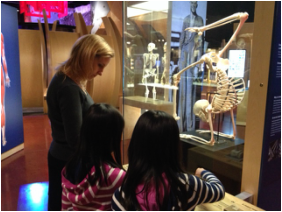 Amelie and Michelle at the exhibition entrance
Amelie and Michelle at the exhibition entrance When we went in the exhibition hall, we saw some interesting exhibits that looked like two ribs, which were to the left of the entrance, and one water-drop, to the right. We all thought that was creative architecture, because the shapes matched the exhibition's topic.
Andrea and Dr. Conboy led us into the giant water-drop-shaped room. This exhibition was called Single Breath. As you may have guessed, this exhibition was about holding your breath. It was inspired by a free-diver named Mandy-Rae Krack from Vancouver. Visitors would experience descending down to 88 metres in one breath, which was the women’s world-record.
There were four seats in the room. The colour of the walls and a "film" of water surfaces above you made it seem like the real thing. The main idea was to listen to the record of Many-Rae Krack explaining what it was like free-diving. The timers started when the voice of Krack announced that she had plunged into the water. You can try to hold your breath, while watching the timers. This enabled you to compare your results with Krack’s 2 minutes 48 seconds. Our record was 1 minute 25 seconds. Our lungs were about to blow up.
We visited the Decision Maze next. It gave you an idea of how life was like climbing Mt. Everest, and how sometimes your seemingly simple decisions mattered between life and death. You should try your best because sometimes, one little comfort can increase the risk of losing greatly. At the end, there was an example of a test for mountain climbers to see if their brains functioned properly after the climb. It felt like it was for kindergarteners, though it will be much harder when you just come down from Mt. Everest.
Beside the Decision Maze, there was the Climbing Wall. There were randomly shaped rocks here and there, along with two strips of rock that looked freshly mined, and some fake snow. The trick was to climb horizontally, which was a lot trickier than you think when you just see it. It was designed like that. In real situations, you'd have rope for protection.
The exhibit behind the Single Breath was called What's for Dinner. This one was like an electronic game. After you typed in info about yourself, and you would start choosing a meal. Then, it would tell you how much calories you should consume daily and how much calories in the dinner you chose. For example, someone like my sister and I (female, 52 lbs 9 years old, and 125 cm in height, not pregnant, nor nursing) needs to consume 1722 calories daily. Guess how much calories was in the dinner we picked? We picked 101% of the 1722 calories. Then we did it again and picked as many of my favourite foods as allowed, the result we received is: “Do you always eat like it is the end of the world?”
Beside the game was a little wooden board. It said: If you eat a large popcorn with topping and one medium soda, to burn that energy, an 80 kg person must walk for 6 hours 17 minutes, jog 2 hours 21 minutes, bicycle 4 hours 43 minutes, or do office work for 12 hours 34 minutes. Andrea said, “After reading this, I vowed I would never ever eat popcorn or soda again.”
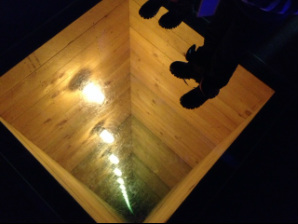 Glass floor exhibition
Glass floor exhibition There were many other exhibitions, explaining how genes worked, what pregnancy was like, what you may look like in the future. Also, you could see who could pump liquid faster up to a certain amount, you or your heart. It was possible to win, but you’d be exhausted afterwards.
This exhibition is very different from the other exhibitions at the science centre. It is a great opportunity to learn about the human body. Try it out! If you visit, a great experience is guaranteed!
Tips:*The amygdala is an almond-shaped set of neurons located deep in the brain’s medial temporal lobe. It plays a key role in the processing of emotions.



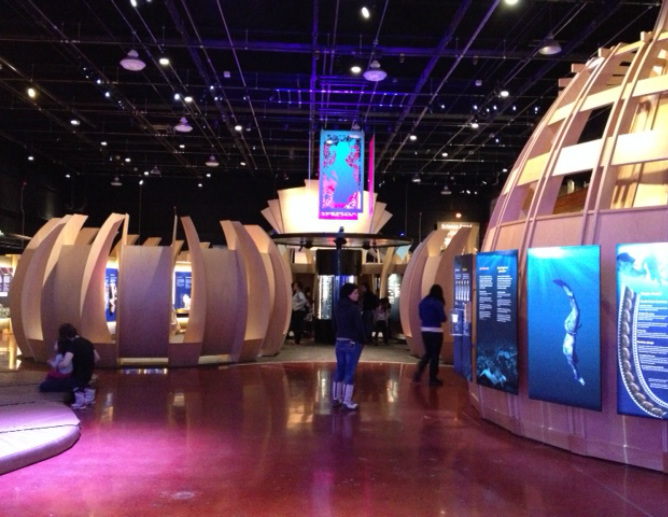
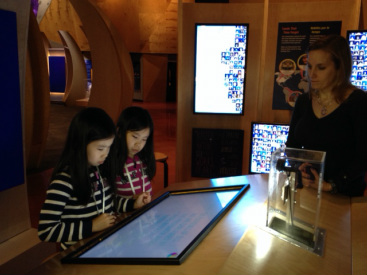
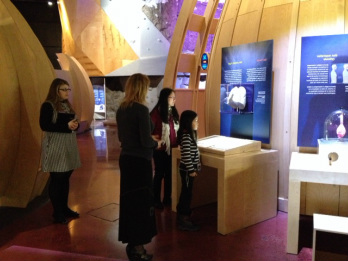

 RSS Feed
RSS Feed